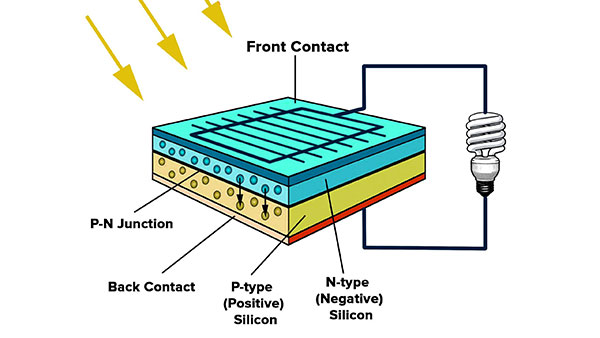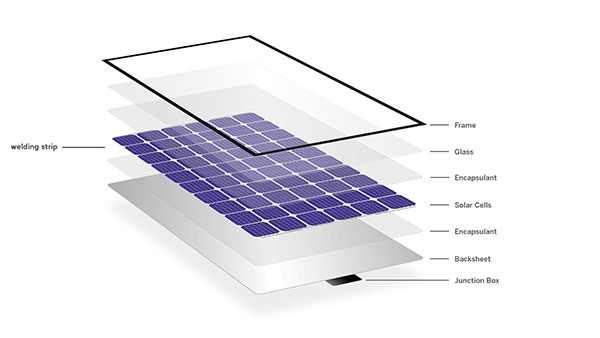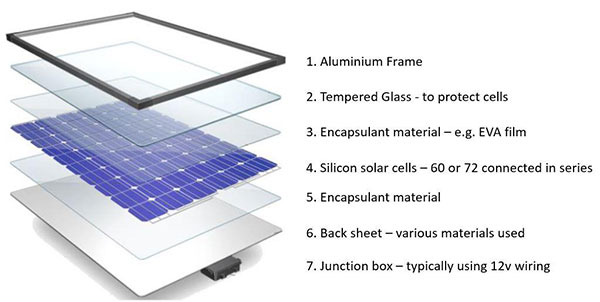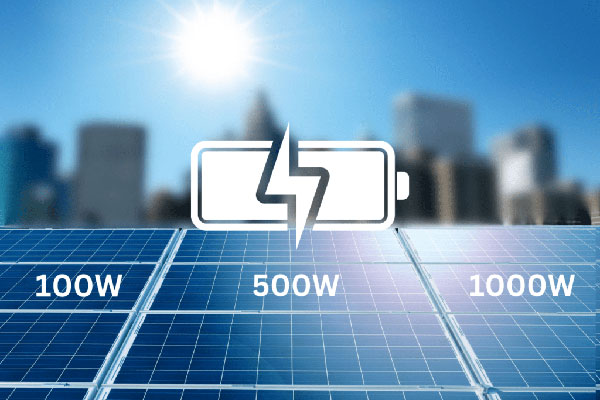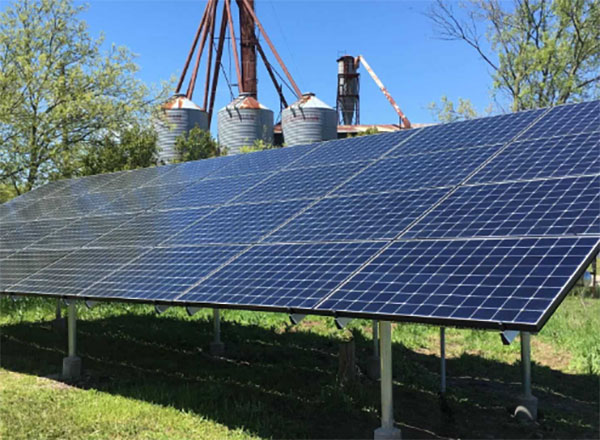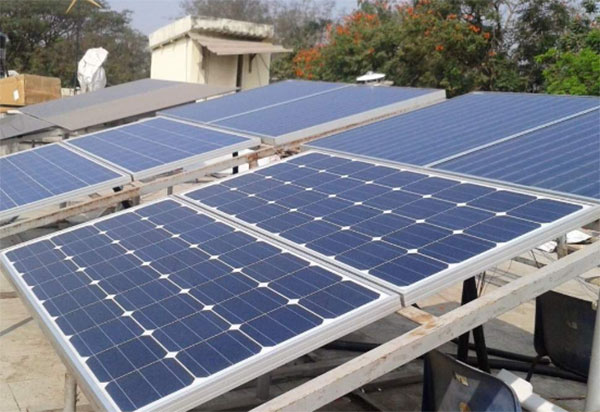Photovoltaic Materials: How They Work and their Applications
Photovoltaic materials are the principal agents used to efficiently utilize solar energy. Another way to define them is as materials specifically created to absorb light and transform photons from sunlight into useful electrical energy. Based on this material, the principal targets are electronic factors that are capable of flowing electrons by carrying and absorbing light. The most commonly used photovoltaic material in the world of science, and technology is silicon. Despite that, various other materials and technology are still tested and developed by researchers to find a more cost-effective and increased efficiency options.
Definition and Principal Facts
Photovoltaic materials are technically defined as semiconductor materials and electronic products that have the ability to generate voltage under light. Moreover, many of such materials have a method with a variable bandgap. Bandgap is restricted by limits to two prongs, which at the first limit is a valence band, followed by conduction. In other terms, the bandgap is capable of being defined based on the materials used and the settings through the frequency range at that period. Similarly, the usage of the variable bandgap will establish the photovoltaic material to fit solar cells.
Types and Application of Silicon
The silicon used in solar photovoltaic in the most popularly used material in the world of science and technology is definitely the silicon. Its popularity is due to the abundance and classical higher efficiency with the usage of a well-developed manufacturing process. The two types used in photovoltaic are crystalline and amorphous silicon. Monocrystalline silicon is a single crystal which is more widely used due to the uniform structure with high efficiency up to 15-20%. On the other hand, it is polycrystalline silicon that is known for a more cyan appearance with a black appearance. But, moreover, a poly-Si is made of multiple silicon crystals, thus, while monocrystalline silicon, has an efficiency of 15-20%, the poly-Si has only an 13-16% in price.
A photovoltaic material with the lowest efficiency defined by 6-8 percent, amorphous silicon presupposes a range of advantages such as flexibility and lightweight properties. In addition, the latter is considered to be suitable for a variety of applications including building-integrated photovoltaics and portable electronic gadgets. The following materials are considered by researchers as alternatives:
- Cadmium telluride: A thin-film material that offers efficiencies up to 16.5 percent. In addition, cadmium telluride is more abundant than silicon, thus becoming a promising alternative in terms of cheap solar cells.
- Copper indium gallium selenide: A thin-film material delivering efficiencies of up to 22 percent. The fact that copper indium gallium selenide performs well even in low-light conditions makes the material a flexible one in terms of environments.
- Organic photovoltaics: Organic photovoltaics utilize organic polymers and small-molecule materials and are considered to be innovation leaders. Despite being less efficient than inorganic materials, organic photovoltaics are popular with opportunities for low-cost and flexible and lightweight solar solutions. The development of advanced photovoltaic materials advances the spread of the technology around the world as well as the appropriateness of production for consumers. Thus, it is crucial to keep up with the times and constant enhancement of the existing materials.
Core Components of Solar Modules
Solar modules are scientifically defined as devices designed to capture sunlight and convert it into electricity. Panels are considered to be the main component of the solar modules. The latter are operated with specific features as well as main features. All in all, the performance and lifetime of the photovoltaic modules are directly affected by the core components.
- Glass: The glass layer is designed to protect the panel from wind, rain, and sunlight itself. It is usually made of tempered glass about 3-4 millimeters thick for durability and longevity. Under the glass is EVA.
- EVA: EVA is an Ethylene-vinyl acetate encapsulant, a thermoplastic material used for encapsulating solar cells for insulation and mechanical support, allowing them to protect the solar cells from the rough exterior.
- Solar cells: Solar cells are the “photovoltaic” part of the panel, which are made of semiconductor materials such as silicon, converting sunlight into direct current electricity work.
- Backsheet: The backsheet is the bottom protective sheet. The backsheet is a protective layer made of a combination of different plastics and sheets, usually, the top layer is plastic to protect the entire panel from rainwater, and the bottom layer is a glass fiber sheet for strength.
- Frame: The frame is a support structure around the entire solar panel. The frame is most commonly made of an anodized aluminum tube forming a rectangular or square structure around the entire panel. This is a simple structure to protect the panel without covering it.
Enhanced Glass Protection
Solar panels’ glass is not a regular sheet of glass, but they are created to protect the panels in most cases. The glass is a tempered soda-lime glass with low iron content for great sunlight permeability. The laminate glass panel is made much thicker than the standard glass, ranging between 3-4 millimeters thick. The process is called tempering, in which glass is heated and then quickly cooled to be 4 to 5 times tougher.
Structural and Conductive Materials
Solar panel must be structurally solid to survive for a long period. The frame is made of anodized aluminum. It not only provides physical support to the solar cells but also helps in heat dissipation. Aluminum provides the perfect balance of weight and strength. Most type of solar frames are made of aluminum, especially those meant to be used for large-scale installations that are used worldwide. The solar cells themselves are made of thin layers of silicon, which is a semiconductor. Silicone contains minute amounts of materials such as boron and phosphorous to increase its conductivity. Silver is used in the solar cells as a coater to make it conductive as possible. Aluminum is also used in making the busbars, which are thin metallic strips used to collect electricity from solar cell. Copper is used to make the wiring. Density is also a socio-political factor mainly with countries that have minerals used in the manufacture.
All the materials used are carefully and scientifically chosen to ensure not only fairly efficient conversion of sunlight into electricity but also long service life of the solar panel. All the materials used will withstand the atmospheric conditions without corroding for many decades which is their service life is the least amount of time. The materials used are of properties perfect for the use; copper is a great conductor of electricity, iron is very hard and also the busbars have properties to make them poor heat conductors.
Silicon: The Premier Material for Solar Cells
Silicon’s semiconductor nature and abundance in the silica sand make is the ideal material for manufacture of solar cells that are used to make solar panels. It has all innate electric qualities that make it the ideal candidate for solar cells. It is because of silicon that 90 percent of the world’s solar cells are made from the material.
Monocrystalline silicon is cut from a single large crystal. This gives it a consistent structure and good electron movement, which means that it can be produced efficiently. Monocrystalline solar panels’ efficiencies can reach up to 15%-20%. The uniform look of monocrystalline cells is deep black color, and it performs best in low light conditions. Polycrystalline silicon is obtained from multiple silicon crystals fused together. This gives it a grainy appearance. This process is economically more efficient but the solar cell developed is not as efficient as monocrystalline solar cells 13%-16%. Polycrystalline solar panels are also easily recognizable by the dark blue tint. The energy conversion process of silicon energy can be segmented into three parts: the starting, middle, and end products. The starting product is silicon cells, and the end product is electricity of alternating currents, which can be used in homes and offices. The middle part of this process converts sunlight to electricity. It starts when sunlight photons strike the solar cell. If a photon of light has more energy than the bandgap energy of the silicon, the photon is absorbed, and its energy is transferred to the silicon atoms. The bandgap energy of silicon is 1.12 eV. A replicated storybeagle tests the photons are able to release an electron from the silicon atom. This electron is then attracted and picked up by the electric field present in the silicon cell. A direct current is formed when these electrons flow in the silicon. DC, the electrons, flow to the semiconductor p-type, and the flow is ended by the two types of metal present at the top and the cell’s end.
The photovoltaic industry is developing rapidly, and while silicon remains the dominant material used in solar cells, new advanced forms have been created, enhancing the efficiency and performance of solar panels. Passivated emitter and rear cell technology has been developed as one such advanced form of silicon cells that adds a layer of passivation on the rear surface to reduce the electron recombination. The result is a significant boost to the cell efficiency, and PERC cells now have an efficiency of up to around 22%. Another form of advanced silicon cells is heterojunction with intrinsic thin layer technology, mixing amorphous silicon layers along with crystalline silicon to create a highly efficient solar cell. HIT cells have demonstrated an efficiency of over 23%, and their high-temperature performance and low-light response are well known.
Silicon cells are not only the traditional silicon panels but may be used in building-integrated photovoltaics. In BIPV systems, solar cells are integrated into the buildings, such as roof tiles, facades, and windows, and not only do they produce clean energy, but also may increase the aesthetic value of the building.
In conclusion, since the world is striving towards clean energy and renewable power, silicon is set to become a dominant material for solar panels in the future. Its efficiency, reliability, and improvements on the current tendencies are all reasons why silicon will remain the preferred material for solar cells. Despite the benefits and advantages silicon cells offer, other materials are also required for the functionality, performance, and safety of solar panels.
Encapsulation For Durability
Encapsulation is an essential process that applies specific materials to wrap and protect the solar cells. Ethylene-vinyl acetate is the most common material utilized for its stability in heat conditions and water resistance. It ensures that solar cells are shielded from the environmental phenomenon, including moisture, dust, and ultraviolet radiation, which may contribute to the entire panel’s wear and tear. The process also applied backsheets typically constructed from polyester or glass fiber reinforced plastic. They provide safety from environmental stress of the structure and contribute to the overall mechanical panel stability.
Framework And Mounting Requirements
The framework and mounting of a solar panel are vital components in consideration of the panel’s stability and the optimal angle of sunlight exposition. Framework is typically made of aluminum or steel, due to the two materials’ high strength and lightweight capability. Mounting solutions are devised to attach the solar panel to a rooftop, ground biased or any other structure. They also have to be adjustable to ensure different angles and differing orientation for ensuring optimal sunlight exposure. The non-penetrating type of mounting solution for solar panels is favored due to the need for minimum surface penetration, which could lead to leaky roofs or penetrated buildings.
Electrical Integration Components
The electrical integration parts, also known as components, of a solar panel are mandatory for the conversion of the DC type of electricity, created by the individual cells, into the AC type of electricity, applicable for the grid’s use and household utilities. Those mandatory components are:
- Busbars – aluminum rods, responsible for gathering the cell electricity into larger electric streams, giant rings, and transporting it to the junction box. They are made from high conductive materials, such as copper, for the optimal minimal energy loss solution.
- Junction boxes are placed at the panel’s edge and accommodate electric connections and protective devices. Thermoplastic materials are commonly used to produce these components; they ensure proper insulation and protection from the external environment.
- The cables are utilized to transmit the electricity produced by the solar panel towards the inverter and electric grid used in a house. It is critical that the wires are made of high-quality insulation, such as cross-linked polyethylene. In addition, cables must be resistant to temperature differences, UV radiation, and mechanical stress.
In conclusion, auxiliary and additional materials and components are critical for solar panels to operate effectively and safely for many years. Technologies used to create encapsulations ensure that the devices are durable and maintain their properties. The frameworks provide the panels with durability, while the electrical integration components that convert and transfer the energy to the inverter and back ensure that the panels are effective and work within the electric system. As such, all of these materials perform a specific function within the device, and if they are applied in the correct way, the panels will be effective in terms of producing electricity and will provide their service for many years.

